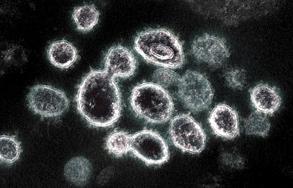 This undated handout image obtained on March 28, 2021, courtesy of The National Institue of Allergy and Infectious Diseases (NIH), shows a transmission electron microscope image of SARS-CoV-2, the virus that causes COVID-19, isolated from a patient in the US. (NATIONAL INSTITUTE OF ALLERGY AND INFECTIOUS DISEASES / AFP)
This undated handout image obtained on March 28, 2021, courtesy of The National Institue of Allergy and Infectious Diseases (NIH), shows a transmission electron microscope image of SARS-CoV-2, the virus that causes COVID-19, isolated from a patient in the US. (NATIONAL INSTITUTE OF ALLERGY AND INFECTIOUS DISEASES / AFP)
Bats dwelling in limestone caves in northern Laos were found to carry coronaviruses that share a key feature with SARS-CoV-2, moving scientists closer to pinpointing the cause of COVID-19.
Researchers at France’s Pasteur Institute and the University of Laos looked for viruses similar to the one that causes COVID-19 among hundreds of horseshoe bats. They found three with closely matched receptor binding domains — the part of the coronavirus’s spike protein used to bind to human ACE-2, the enzyme it targets to cause an infection.
The finding shows that viruses closely related to SARS-CoV-2 exist in nature, including in several Rhinolophus, or horseshoe bat, species. The research supports the hypothesis that the pandemic began from a spillover of a bat-borne virus
The finding, reported in a paper released Friday that’s under consideration for publication by a Nature journal, shows that viruses closely related to SARS-CoV-2 exist in nature, including in several Rhinolophus, or horseshoe bat, species. The research supports the hypothesis that the pandemic began from a spillover of a bat-borne virus.
The three viruses found in Laos, dubbed BANAL-52, BANAL-103, and BANAL-236, are “the closest ancestors of SARS-CoV-2 known to date,” said Marc Eloit, head of pathogen discovery at the Pasteur Institute in Paris, and co-authors. “These viruses may have contributed to SARS-CoV-2’s origin and may intrinsically pose a future risk of direct transmission to humans.”
READ MORE: WHO reiterates novel coronavirus is 'natural in origin'
The receptor binding domains of three Laos coronaviruses are closer to that of SARS-CoV-2 than to the RaTG13 virus identified in Rhinopholus affinis bats from the Mojiang mineshaft in Yunnan province, that was regarded as the pandemic strain’s closest match. The BANAL-236 virus has an almost identical receptor binding domain to the pandemic virus, according to the paper.
“The receptor binding domain of SARS-CoV-2 looked unusual when it was first discovered because there were so few viruses to compare it to,” said Edward Holmes, an evolutionary biologist at the University of Sydney, who wasn’t involved in the research.
Tracing ancestors
“Now that we are sampling more from nature, we are starting to find these closely related bits of gene sequence,” Holmes said in an email Saturday. “Eventually, with more sampling, the natural ancestry of the entire SARS-CoV-2 genome will be revealed.”
ALSO READ: The clever game of the coronavirus
None of the bat viruses isolated in Laos harbors a so-called furin cleavage site in the spike that facilitates cell entry. It’s a feature of the SARS-CoV-2 virus that has led some scientists to theorize that it was created in a laboratory. No evidence supporting the lab-leak theory has emerged.
This study emphasizes that bat coronaviruses that have the potential to infect humans readily exist in nature and could emerge any point. This is the clear risk for the future.
Edward Holmes, evolutionary biologist at the University of Sydney
The lack of furin cleavage may be explained by insufficient sampling in bats, or by acquisition of the furin cleavage site during chains of transmission in an alternate animal host, or during unreported circulation in humans in the early stages of the outbreak when the virus may have caused few symptoms, the authors said.
“Our results pinpoint the presence of new bat sarbecoviruses that seem to have the same potential for infecting humans as early strains of SARS-CoV-2,” they said.
Guano collectors
People who spend time in or close to caves, such as guano collectors, are particularly at risk of being exposed. Further investigations are needed to assess if people exposed to bats have been infected by one of these viruses and whether they have antibodies that may provide protection against subsequent SARS-CoV-2 infections.
ALSO READ: Bats likely origin of new coronavirus, says study
“This paper is really interesting and we need more research like it,” said Maria Van Kerkhove, the World Health Organization’s technical lead for COVID-19, in an email.
The researchers studied 645 bats from 46 species captured on four sites — in Fueng and Meth districts of Vientiane province, and in Namor and Xay districts in Oudomxay province — between July 2020 and January 2021. The bats live in the limestone karstic terrain common to China, Laos, and Vietnam in the Indochina peninsula.
The paper highlights the diversity of SARS-CoV-2-like viruses present in bats in Southeast Asia, Holmes said.
“This study emphasizes that bat coronaviruses that have the potential to infect humans readily exist in nature and could emerge any point. This is the clear risk for the future.”


